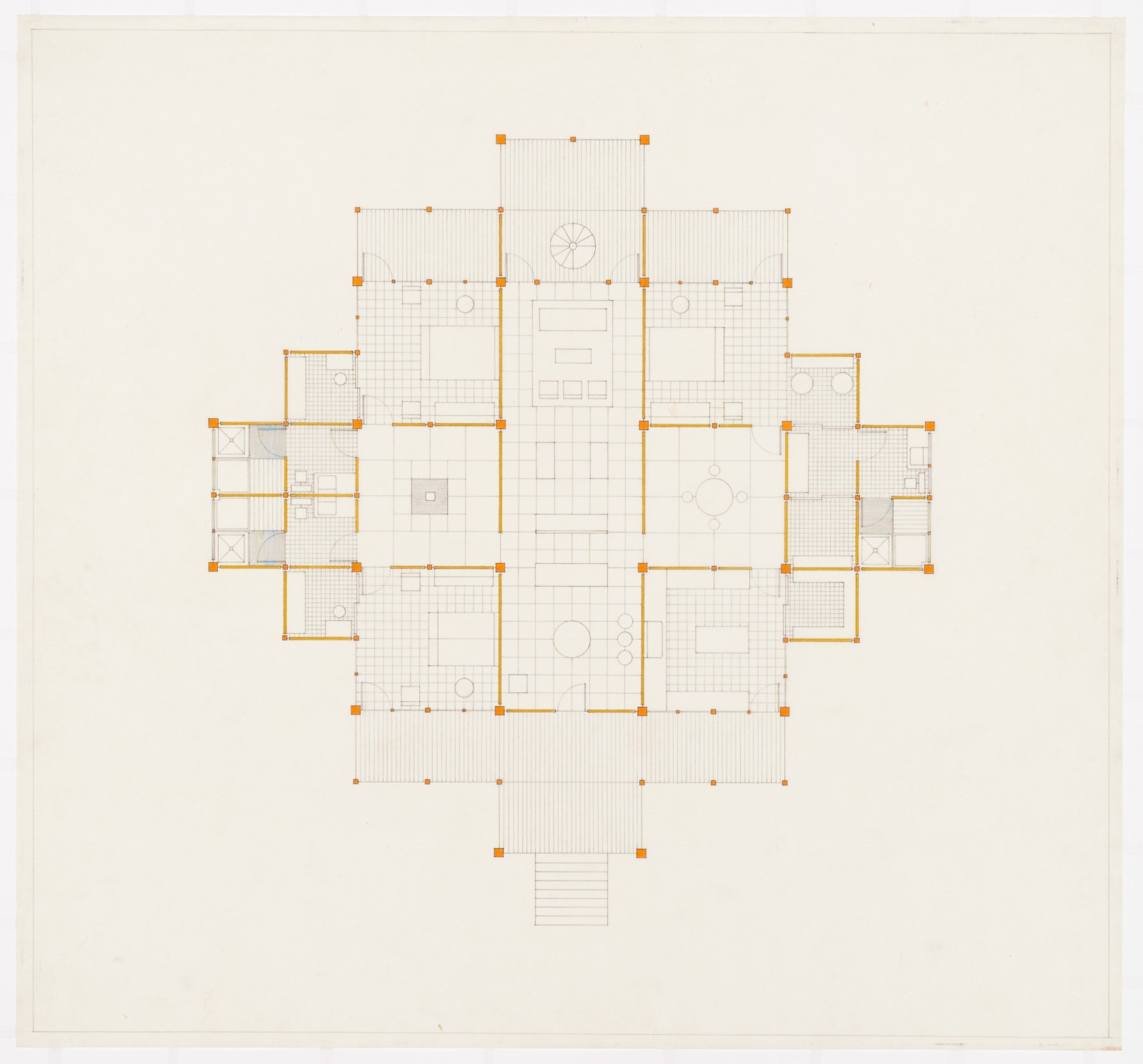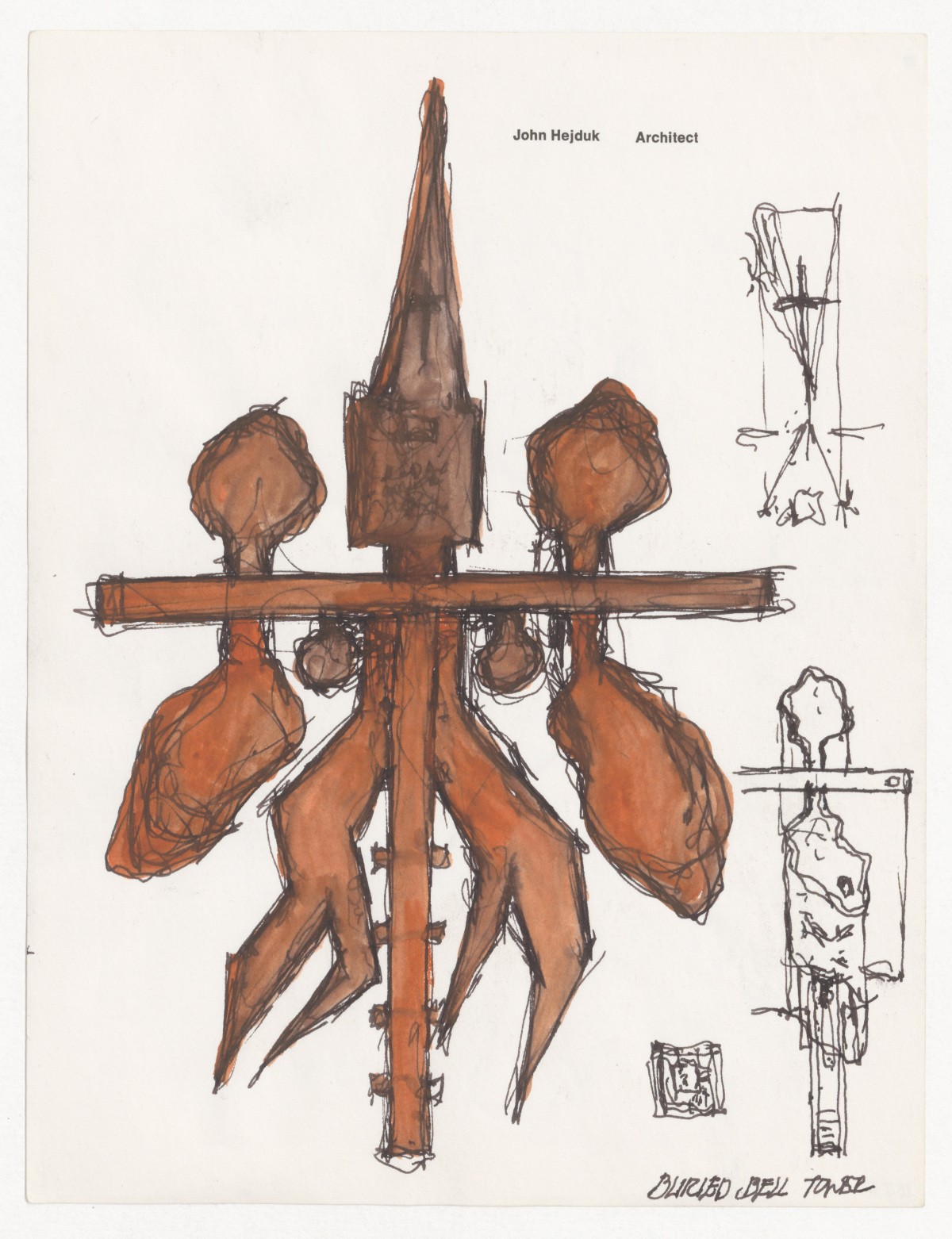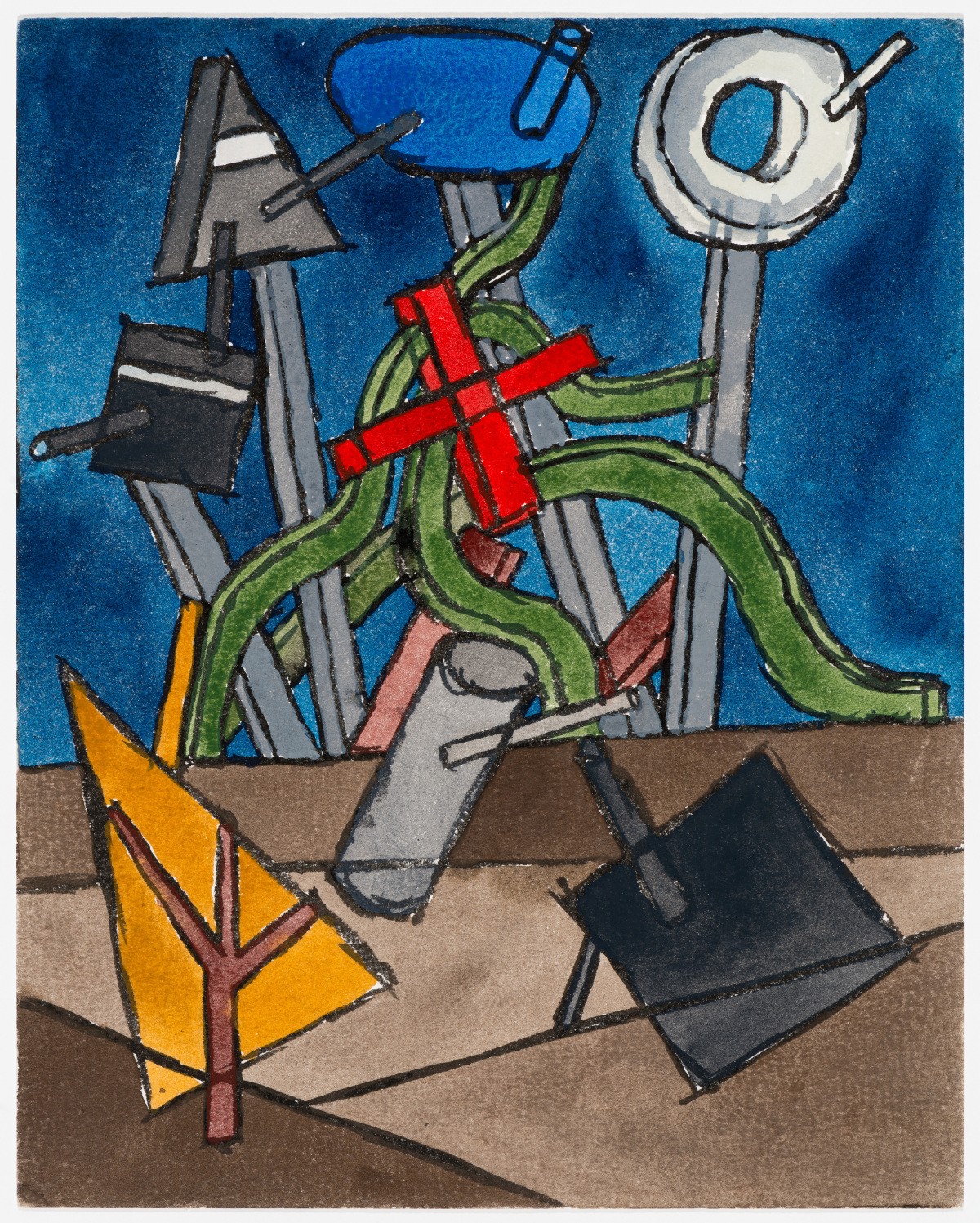
The Power Station of Art (PSA) will host the exhibition “John Hejduk: Shanghai Masque”from 13 November 2021 to 15 February 2022, presenting a unique case in the 20th-century architecture history. John Hejduk (1929-2000) was not only a distinguished architect, educator, and historian, but also an artist and poet. Although most of his architectural imaginations and cross-media practices exist only on paper, Hejduk’s unremitting efforts have succeeded in expanding the scope of architectural field. His work helped shape various disciplines and continues to inspire generations of architects and artists. As the first large-scale exhibition of Hejduk in Asia, the exhibition will showcase paintings, installations, manuscripts, videos, and documents in an abundant yet detailed manner, and stage large-scale “structures” especially reproduced for the exhibition by the students and faculty from Southeast University. Borrowing the format of a sudden masque, the exhibition will welcome iconic characters created by Hejduk to the hall. Following the architectural symphony composed by architecture and other disciplines, viewers will gradually decipher Hejduk’s practices and thoughts and eventually approach his world.

"Plan for Texas House 1", 1954-1963, graphite with coloured pencil on translucent paper, 80x84cm. Courtesy of John Hejduk fonds and Canadian Centre for Architecture. ?CCA
The title of the exhibition is inspired by the best-known works of John Hejduk “Masques” (1979-2000). The masque was a form of courtly entertainment that originated in England in the 16th and 17th centuries. The word can also refer to the stage set involved, and architects were often invited to participate in the design of stages and costumes. Hejduk drew attention to the architect Inigo Jones, who was the first to participate in such design in the 18th century. Hejduk believed that Jones mastered all the illusions on stage, by not only manipulating the architecture, but also employing materials such as sound and light. In the late 1970s, Hejduk started to develop a series of “structures” titled “Masques”. Tailored to different urban narratives, such “structures” do not possess any conventional architectural forms and functions, and are usually composed of basic geometric shapes and their deformations, occasionally accompanied by some biomorphic elements. Hejduk’s “structures” of all shapes and sizes are endowed with different personalities and expressions, as if they were mask-wearing actors who tour different cities and perform different narratives. Therefore, the “nomadic” nature embedded in the “Masques” represents Hejduk’s intervention in society in an anti-monumental way, in his words, “we are in a nomadic age.”

"Berlin Night: Jewish Museum: Buildings of Research, Structure of Witness, Tower for the Protection of Memories", 1989, watercolour on paper, 21.5x27cm. Courtesy of John Hejduk fonds and Canadian Centre for Architecture. ?CCA
The “Shanghai Masque” starts with a gigantic installation “Book Market” - an in-situ reconstruction of Hejduk's iconic “structures”, through which viewers can freely wander into the exhibition. The Blue Hall presents the “House for the Inhabitant Who Refused to Participate”, revealing how Hejduk reflected on the relationship between architecture and its social context in an allegorical way. In the Black Hall that follows, “Church”, “Death House”, “Court House” and “Prison House”, the four characters seen in the “Lancaster/Hanover Masque” are presented in juxtaposition with the “Berlin Night” project - a project Hejduk created in later years - to traverse his philosophical thinking about time and society.

"Plan for Church Complex and Sketches (from the series "Pewter Wings, Golden Horns, Stone Veils")", 1994-1996, pen and ink and watercolour on wove paper, 28x22cm. Courtesy of John Hejduk fonds and Canadian Centre for Architecture. ?CCA
As an innovative architectural educator, John Hejduk taught at The Cooper Union for the Advancement of Science and Art from 1965 to 2000, subsequently named as Professor of Architecture and Dean of the School of Architecture, where he leveraged education to influence generations of prospective architects. Between 1954 and 1956, he was invited to teach at the University of Texas, and formed the “Texas Rangers” with other lecturing young architects–the group is known for their emphasis on visual and formal complexity and for their development of an innovative curriculum, including the “Texas House” (1954-1962) for teaching demonstration and nine-square grid training, and the “Diamond House” (1962-1968) developed with a 45-degree rotation of its axis and plane under the influence of Piet Mondrian and Cubism. Later, Hejduk kept experimenting with the apex and diagonal projection plane of the rhombus and continued to explore spatial reconfigurations and compressions, eventually came up with the “Wall Houses” (1964-1970) in which time collapses. And that’s why the White Hall, the final chapter of the PSA exhibition, will resemble a brightly lit operating theatre, as if it were trying to ruthlessly and convincingly dissect Hejduk's anatomy-like experiments and thoughts.

"Berlin Night: structures for Braque, Gris, Beckmann and Leger", 1989, watercolour on paper, 27.1x21.6cm. Courtesy of John Hejduk fonds and Canadian Centre for Architecture. ?CCA
John Hejduk firmly believed that “Art, be it painting, literature or architecture, is the remaining shell of thought.” For him, architecture, painting and poetry are all his language, influencing each other and contributing to each other. Therefore, the PSA exhibition will not only highlight Hejduk’s works in painting and poetry, but also screen one of his few interviews: John Hejduk: Builder of Worlds, a sit-down interview between Hejduk and his long-time friend, poet David Shapiro. Through the interview, viewers will get a glimpse of Hejduk’s exclusive insights into his personal development, his architectural predecessors, and the symptoms of his time.
About the architect
John Hejduk (1929-2000) was an American architect, educator, artist, and poet. Hejduk was born in New York in 1929 during the Great Depression in the United States. He studied architecture at the The Cooper Union, the University of Cincinnati, and The Graduate School of Design, Harvard University before working at a number of architectural practices including I. M. Pei & Partners. From 1954 to 1956, he was a Professor of Architecture at the University of Texas, Austin where he was part of an innovative group of architectural educators that would later be known as the “Texas Rangers”. Colin Rowe, Bernard Hoesli, and Robert Slutzky were among this group whose pioneering pedagogy laid a new foundation for global architectural education. In the 1950s and 1960s, when the architectural community started to rethink Modernism, Hejduk began a deep study of Modernism and its foundational ideals. In 1964, he returned to The Cooper Union, his alma mater, serving as the Director of the Architecture Department. He served as the Dean of the School of Architecture at the Cooper Union from 1975 to 2000. Hejduk’s creative career yielded influential projects and series such as the Texas Houses (1954-1962), the Diamond Houses (1962-1968), and the Wall Houses (1964-2000), and the Masques (1979-2000). Beginning in the 1980s, his architectural “structures” began to be constructed around the world by collaborative groups of students and architect interested in his ideas and ethos. These include the Wall House 2 in Groningen, The Netherlands-- a project that was finished in 2001 a year after his passing. In 2016, the City of Prague, in the Czech Republic unveiled the permanent installation of his memorial to the dissident Jan Palach also known as The House of the Suicide and the House of the Mother of the Suicide. Beyond architecture, Hejduk had a passion for using painting and poetry to approach his thoughts about form, expression, and social convention, and published more than 20 books and poetry collections. The Canadian Centre for Architecture (CCA) in Montreal, Canada holds The John Hejduk Archive that encompasses the architect's manuscripts, sketches, paintings, videos, and other documents that record his life and creations. His work and dedication to the education of the architect continues to inspire students, scholars, and architects around the world.
About the curators
Yung Ho Chang, founding partner and principal architect, Atelier Feichang Jianzhu (FCJZ). Educated both in China and in the US, Chang received Master of Architecture degree from the University of California at Berkeley in 1984. Since 1992, he has been practicing in China and established Atelier Feichang Jianzhu (FCJZ) with Lijia Lu in 1993. He has won a number of prizes and recognitions, such as First Place in the Shinkenchiku Residential Design Competition in 1986, a Progressive Architecture Citation Award in 1996, the 2000 UNESCO Prize for the Promotion of the Arts, and the Academy Award in Architecture from American Academy of Arts and Letters in 2006, 2016 China Architecture Media Award Excellence in Practice Prize, and Honorary Membership of AIA Hong Kong. FCJZ has been recognized as one of the 100+ Best Architecture Firms 2019 by Domus magazine. Recently, Jishou Art Museum has won the American Institute of Architects (AIA) 2020 Architecture Award and the ArchDaily China Building of the Year 2020 Award. He has published a number of books and monographs, including Exhibition as Construction Experiment in English, World Architecture special issue – The Modernity of Making: Yung Ho Chang in Chinese/English, Yung Ho Chang / Atelier Feichang Jianzhu: A Chinese Practice in English/French and Yung Ho Chang: Luce chiara, camera oscura in Italian. He participated in many international exhibitions of art and architecture, including six times in the Venice Biennale since 2000. He has taught at various architecture schools in the USA and China; he was a Professor and Founding Head of Graduate Center of Architecture at Peking University from 1999 to 2005; he held the Kenzo Tange Chair at Harvard GSD in 2002, the Eliel Saarinen Chair at Michigan in 2004, and between 2005 and 2010, he headed the Architecture Department at MIT. He was also a Pritzker Prize Jury member from 2012 to 2017.
Ge Ming is currently a professor and deputy dean of the School of Architecture of Southeast University, and concurrently the deputy director of the Architectural Review Committee of the Architectural Society of China, an editorial board member of "The Architect", and an editorial board member of "Frontiers of Architecture". He was a visiting scholar at the Swiss Federal Institute of Technology in Zurich, Switzerland (ETH), and a visiting professor at the School of Architecture of the University of Hong Kong. He mainly engaged in the research and teaching of architecture and garden design, architectural theory and related fields.
He was one of the chief designers of the China Pavilion at the Venice International Architecture Biennale in 2008, one of the participating designers of the Hong Kong Pavilion at the Venice International Architecture Biennale in 2018, and also participated in the first and second China International Architecture Biennale (2004, 2006), Harvard University Chinese Contemporary Architecture Exhibition (2016) and many other architectural exhibitions. Weiyuan and other design works have won silver award of Architectural Creation Award of China Architectural Society, and other awards, and have been published in international and domestic magazines for many times. He has been invited to participate in or organize a number of design competitions, exhibitions and academic activities domestic and abroad.
He proposed a number of architectural and garden design methods and design teaching methods such as "Raumplan", "Structure-ing", "De-formal Planning" and " Six Approaches to Garden". In the field of conceptual architecture, he once guided students and won the first prize for young students in the first China International Architectural Art Biennale. Participated in the cooperative research, design and teaching between the school of architecture of Southeast University and international institutions such as ETH in Zurich, MIT in the United States, Tokyo Institute of Technology in Japan and AA school in the United Kingdom.
He Weiling is a tenured Associate Professor at the College of Architecture, Associate Department Head of Undergraduate Programs, and former Director of the Academy for Visual and Performing Arts in Texas A&M University. She is currently serving on the board of National Conference on Beginning Design Students. She received a M. Arch degree from Southeast University, China, and a PhD in design theory from Georgia Institute of Technology, studying John Hejduk’s early architectural work in relation to painting, poetry, and drawing. Her further studies on Hejduk’s drawings received the Research and Development Grant from Graham Foundation for Advanced Studies in Fine Arts.
About the exhibition
Dates: 13/11/2021 — 15/02/2022
Organized by Power Station of Art
Co-organizer: Southeast University School of Architecture
Special Support by Shanghai International Culture Association
Curators: Yung Ho Chang, Ming Ge, Weiling He
Venue: 3F, PSA
Courtesy of the artist and the Power Station of Art.




























